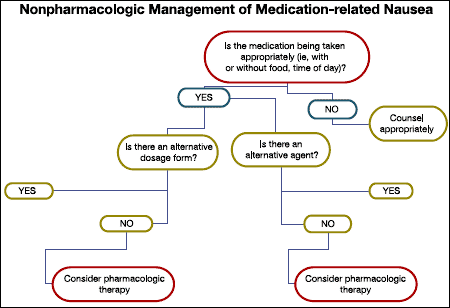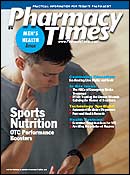Publication
Article
Pharmacy Times
Side Effect Solutions: Helping Patients Avoid Drug-induced Nausea
Author(s):
Pharmacists can help patients avoid this commonly reported side effect and promote medication adherence.
Dr. McNatty is an assistant professor of pharmacy practice at Midwestern University College of Pharmacy, Glendale, Arizona.
Nausea is one of the most commonmedication side effects that patients report, as virtuallyall agents have the ability to cause stomach disturbances. Nausea can range from a slight annoyance to a debilitating condition causing disruption to a patient's daily life.
Medication-related nausea can have a profound impact on patient outcomes because nonadherence to prescribed therapy can lead to treatment failure. A loss of appetite may occur, which can lead to poor nutrition. Nausea also can have psychological effects on patients, and they may become apprehensive about taking medications in the future. Patient education by pharmacists and other health care professionals can reduce substantially the likelihood of nauseaas a side effect and help patients achieve optimum benefit from medicationtherapy.
Chemotherapy-induced Nausea
Chemotherapy-induced nausea is the most studied type of medication-related nausea. Nausea and vomiting due to chemotherapy is a very common and debilitating event for patients undergoing this treatment, and guidelines written specifically for this side effect have been developed.1,2

Nausea and vomiting can cause dehydration,malnourishment, increased anxiety, and stress in a patient populationalready at high risk for medication-related complications. Nausea and vomiting are categorized as acute, delayed, anticipatory, breakthrough, and refractory; in the ambulatory care setting, delayed and anticipatory nauseaare seen frequently.
Medication-induced Nausea
When a patient who is not receiving chemotherapy presentswith nausea, it is often difficultto determine the cause. In addition to medications, other causes (eg, migraine, emotional response, pregnancy, and gastrointestinaldisorders) must be considered.
Nausea caused by medicationsis typically acute rather than chronic and usually is seen shortly after starting a medication.3 Medications can cause nausea via severalmechanisms. Dopaminergic agonists, nicotine, digoxin, and opiates have been shown to act on the area postrema. Some agents (eg, nonsteroidal anti-inflammatorydrugs [NSAIDs] and erythromycin) activate peripheral afferent pathways, stimulating the brainstem nuclei.3 Nausea also can be induced through stimulation and activation of the chemoreceptor triggerzone (CTZ). Stimuli cause the CTZ to recognize a substance as foreign and activate the vomiting center.
The most common substances to cause stimulation are chemotherapy drugs, opiates, and ipecac syrup. Many other drugs (eg, antibiotics, NSAIDs, selective serotonin reuptake inhibitors [SSRIs], and digoxin) also can cause the activation of the CTZ.4 The mechanism associated with a number of medication classes known to cause nausea remains unclear. Some of these include anti-arrhythmics, antihypertensives,diuretics, oral hypoglycemics, and oral contraceptives.3
Prevention
Preventing nausea caused by medicationoften can be achieved with a few simple reminders. Unless an agent is meant to be taken on an empty stomach, patients can be advised to take their medications with food. This is an easy way to prevent nausea, especially with notorious offenders, such as antibiotics, NSAIDS, and multivitamins. The time of day a medication is taken may be an important consideration when preventingnausea caused by dizziness. Taking medications such as SSRIs at bedtime prevents the vomiting center from being activated by dizziness because the body is asleep.4
o n l i n e
A complete discussion of treatment guidelines for chemotherapy-related nausea can be accessed at www.nccn.org/patients/patient_gls.asp.
If these simple interventions are noteffective, the next step is to identify any alternative agents that can be used to provide equal efficacy with less nauseafor the patient. If the nausea is being caused by any of the excipients, a simple formulation switch may help. The patient can try either the same product from a different manufacturer or change formulations—from a tablet to a liquid, for example. If this is not possible or does not work, changing to an alternativeagent with the same mechanism of action may alleviate the nausea. Finally, if this option is not possible or proves to be ineffective, changing to a medication with an entirely different mechanism of action may be warranted. These nonpharmacologicinterventions are summarizedin the Figure.
Pharmacologic Agents
When nonpharmacologic recommendationsdo not work, patients can turn to pharmacologic agents to prevent and/or treat nausea caused by medication use. Dopamine antagonists, such as promethazineand prochlorperazine, are especiallyeffective for opioid-induced nausea, but can be beneficial for nausea caused by other medications as well. They are a good choice for short-term offenders, such as antibiotics and NSAIDS. Long-term use may be limited by extrapyrimidalside effects. The use of serotonin receptor antagonists (eg, ondansetron and granisetron) may be beneficial for long-term prevention of nausea. The use of this class of agents is often limited by cost to the patient.
Many patients consider nausea to be a sign of an allergic reaction. This can have profound effects on future therapy. If an allergy is documented in a patient's profile,it could lead to the choice of a less-than-optimal agent for future treatment.
Pharmacists can play a key role in makingsure every patient understands the difference between an allergic reactionand an adverse reaction. An ideal time to do this is during the initial contact with the patient while getting a medication history. Verifying allergies and the specific reaction caused by the offending agents is the first step in identifying misinterpretedreactions. In addition, health care professionals should be vigilant about documenting new allergies/intolerances and counseling patients appropriately about these issues.
Nausea is a common medication-related side effect with many potential causes. Nausea can have a significant impact on a patient's physical and psychologicalhealth. Proper counseling on prevention and treatment of nausea due to medication use can help patients betterunderstand how to take their medicationsfor optimum benefit with minimal side effects.
Figure

References
- Jordan K, Sippel C, Schmoll HJ. Guidelines for antiemetic treatment of chemotherapy-induced nausea and vomiting: past, present, and future recommendations. Oncologist. 2007;12:1143-1150.
- American Cancer Society and National Comprehensive Cancer Network. Nausea and Vomiting: Treatment Guidelines for Patients with Cancer (Version IV 2007). www.nccn.org/patients/patient_gls.asp.
- Quigley EM, Hasler WL, Parkman HP. AGA technical review on nausea and vomiting. Gastroenterology. 2001;120:263-286.
- Garrett K, Tsuruta K, Walker S, Jackson S, Sweat M. Managing nausea and vomiting. Current strategies. Crit Care Nurse. 2003;23(1):31-50.







